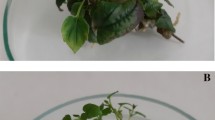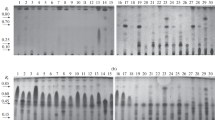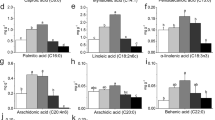Abstract
Cell suspension cultures of Camellia sinensis were established in 250 ml shake flasks. Flasks contained 50 ml liquid medium of either Murashige and Skoog (MS), N/5 MS or Heller medium containing different levels of 6-benzyladenine (BA) (0.05–2 mg l−1), 2,4-dichlorophenoxyacetic acid (2,4-D) (1–10 mg l−1), and sucrose (10–50 g l−1). Moreover, the pH of the medium was varied from 5.2–6.2. In addition, cultures were subjected to light irradiation as well as to complete darkness. Following optimization of aroma and terpenoid extraction methods, cell cultures were analyzed for the volatile compounds using GC/MS. A total of 43 compounds were identified using the micro SDE apparatus. Among the major monoterpenoids obtained were α-terpineol and nerol. Moreover, other high aroma-value compounds, including 2-ethyl hexanol, benzyl alcohol, benzene acetaldehyde, nonanal and phenylethylalcohol were also detected. The highest levels of these compounds were obtained from cell suspension cultures grown in MS medium containing 5 mg l−1 2,4-D, 1 mg l−1 BA and 30 g l−1 sucrose at pH of 5.8 with incubation in complete darkness.




Similar content being viewed by others
References
Abbasi BH, Ahmad N, Fazal H, Rashid M, Mahmood T, Fatima N (2010) Efficient regeneration and antioxidant potential in regenerated tissues of Piper nigrum L. Plant Cell Tiss Org Cult 102(1):129–134. doi:10.1007/s11240-010-9712-x
Agarwal B, Singh U, Banerjee M (1992) In vitro clonal propagation of tea (Camellia sinensis (L.) O. Kuntze)In vitro clonal propagation of tea (Camellia sinensis (L.) O. Kuntze). Plant Cell Tiss Org Cult 30:1–5
Aridogan BC, Baydar H, Kaya S, Demirci M, Ozbasar D, Mumcu E (2002) Antimicrobial activity and chemical composition of some essential oils. Arch Pharm Res 25(6):860–864
Bae TW, Park HR, Kwak YS, Lee HY, Ryu SB (2005) Agrobacterium tumefaciens-mediated transformation of a medicinal plant Taraxacum platycarpum. Plant Cell Tiss Org Cult 80(1):51–57
Banthorpe DV, Bates MJ, Ireland MJ (1995) Stimulation of accumulation of terpenoids by cell suspensions of Lavandula angustifolia following pretreatment of parent callus. Phytochemistry 40(1):83–87
Bitam F, Gavatta ML, Manzo E, Dibi A, Gavagnin M (2008) Chemical characterisation of the terpenoid constituents of the Algerian plant Launaea arborescens. Phytochemistry 69(17):2984–2992
Butenko RG (1999) Biology of higher plant cells in vitro as the basis for biotechnology. FBK-PRESS, Moscow
Chen QC, Youn U, Min BS, Bae K (2008) Pyronane monoterpenoids from the fruit of Gardenia jasminoides. J Nat Prod 71(6):995–999
Clark JB, Chamblee TS (1992) Acid-catalyzed reactions of citrus oils and other terpene-containing flavors. In: Charalambous G (ed) Off-flavors in food beverages. Elsevier Science, New York, pp 229–285
Crowell PL (1999) Prevention and therapy of cancer by dietary monoterpenes. J Nutr 129(3):775–778
Davis EM, Croteau R (2000) Cyclization enzymes in the biosynthesis of monoterpenes, sesquiterpenes, and diterpenes. Top Curr Chem 209:53–95
Franco MRB, Shibamoto T (2000) Volatile composition of some Brazilian fruits: Umbu-caja (Spondias citherea), camu–camu (Myrciaria dubia), arapa-boi (Eugenia stipitata), and cupuacu (Theobroma grandiflorum). J Agr Food Chem 48(4):1263–1265
Girard B, Fukumoto L, Mazza G, Delaquis P, Ewert B (2002) Volatile terpene constituents in maturing Gewurztraminer grapes from British Columbia. Am J Enol Viticult 53(2):99–109
Godefroot M, Sandra P, Verzele M (1981) New method for quantitative essential oil analysis. J Chromatogr 203:325–335
Jirovetz L, Buchbauer G, Schmidt E, Stoyanova AS, Denkova Z, Nikolova R, Geissler M (2007) Purity, antimicrobial activities and olfactoric evaluations of geraniol/nerol and various of their derivatives. J Essent Oil Res 19(3):288–291
Katoh S, Croteau R (1998) Individual variation in constitutive and induced monoterpene biosynthesis in grand fir. Phytochemistry 47(4):577–582
Kawakami M, Ganguly SN, Banerjee J, Kobayashi A (1995) Aroma composition of oolong tea and black tea by brewed extraction method and characterizing compounds of darjeeling tea aroma. J Agr Food Chem 43(1):200–207
Kim TH, Shin JH, Baek HH, Lee HJ (2001) Volatile flavour compounds in suspension culture of Agastache rugosa Kuntze (Korean mint). J Sci Food Agr 81(6):569–575
Liu K, Rossi PG, Ferrari B, Berti L, Casanova J, Tomi F (2007) Composition, irregular terpenoids, chemical variability and antibacterial activity of the essential oil from Santolina corsica Jordan et Fourr. Phytochemistry 68(12):1698–1705
Liu YJ, Gao LP, Xia T, Zhao L (2009) Investigation of the site specific accumulation of catechins in the tea plant (Camellia sinensis (L.) O. Kuntze) via vanillin-HCl staining. J Agr Food Chem 57(21):10371–10376
Lopez MG, Sanchez-Mendoza IR, Ochoa-Alejo N (1999) Compartive study of volatile components and fatty acids of plants and in vitro cultures of parsley (Petroselinum crispum (Mill) Nym ex hill). J Agr Food Chem 47(8):3292–3296
Loza-Tavera H (1999) Monoterpenes in essential oils: biosynthesis and properties. Adv Exp Med Biol 464:49–62
Mccaskill D, Gershenzon J, Croteau R (1992) Morphology and monoterpene biosynthetic capabilities of secretory-cell clusters isolated from glandular trichomes of peppermint (Mentha piperita L). Planta 187(4):445–454
Mcdonald KA, Jackman AP (1989) Bioreactor studies of growth and nutrient utilization in alfalfa suspension-cultures. Plant Cell Rep 8(8):455–458
Mondal TK, Bhattacharya A, Laxmikumaran M, Ahuja PS (2004) Recent advances of tea (Camellia sinensis) biotechnology. Plant Cell Tiss Org Cult 76(3):195–254
Murashige T, Skoog F (1962) A revised medium for rapid growth and bioassays with tobacco tissue culture. Physiol Plant 15:473–497
Nabeta K, Ohnishi Y, Hirose T, Sugisawa H (1983) Monoterpene biosynthesis by callus tissues and suspension cells from Perilla species. Phytochemistry 22(2):423–425
Niedz RP, Moshonas MG, Peterson B, Shapiro JP, Shaw PE (1997) Analysis of sweet orange (Citrus sinensis (L.) Osbeck) callus cultures for volatile compounds by gas chromatography with mass selective detector. Plant Cell Tiss Org 51(3):181–185
Nikolaeva TN, Zagoskina NV, Zaprometov MN (2009) Production of phenolic compounds in callus cultures of tea plant under the effect of 2, 4-D and NAA. Russ J Plant Physl 56(1):45–49. doi:10.1134/S1021443709010075
Nurazah Z, Radzali M, Syahida A, Maziah M (2009) Effects of plant growth regulators on callus induction from Cananga odorata flower petal explant. Afr J Biotechnol 8(12):2740–2743
Oltramari AC, Wood KV, Bonham C, Verpoorte R, Caro MSB, Viana AM, Pedrotti EL, Maraschin RP, Maraschin M (2004) Safrole analysis by GC-MS of prototrophic (Ocotea odorifera (Vell.) Rohwer) cell cultures. Plant Cell Tiss Org 78(3):231–235
Omidi Y, Zare K, Nazemiyeh H, Movafeghi A, Khosrowshahli M, Motallebi-Azar A, Dadpour M (2010) Bioprocess engineering of Echium italicum (L.): induction of shikonin and alkannin derivatives by two-liquid-phase suspension cultures. Plant Cell Tiss Org Cult 100(2):157–164. doi:10.1007/s11240-009-9631-x
Pati PK, Kaur J, Singh P (2011) A liquid culture system for shoot proliferation and analysis of pharmaceutically active constituents of Catharanthus roseus (L.) G. Don. Plant Cell Tiss Org 105(3):299–307. doi:10.1007/s11240-010-9868-4
Predieri S, Rapparini F (2007) Terpene emission in tissue culture. Plant Cell Tiss Org Cult 91(2):87–95. doi:10.1007/s11240-007-9250-3
Pretto FR, Santarem ER (2000) Callus formation and plant regeneration from Hypericum perforatum leaves. Plant Cell Tiss Org 62(2):107–113
Ravichandran R, Parthiban R (1998) Occurrence and distribution of lipoxygenase in Camellia sinensis (L.) O Kuntze and their changes during CTC black tea manufacture under southern Indian conditions. J Sci Food Agr 78(1):67–72
Rawat R, Gulati A, Babu GDK, Acharya R, Kaul VK, Singh B (2007) Characterization of volatile components of Kangra orthodox black tea by gas chromatography-mass spectrometry. Food Chem 105(1):229–235
Sahai OM (1994) Plant tissue culture. In: Gabelman A (ed) Bioprocess production of flavour, fragrances and color ingredients. Wiley, New York
Sandal I, Bhattacharya A, Ahuja PS (2001) An efficient liquid culture system for tea shoot proliferation. Plant Cell Tiss Org Cult 65(1):75–80
Santos AV, Arrigoni-Blank MF, Blank AF, Diniz LEC, Fernandes RMP (2011) Biochemical profile of callus cultures of Pogostemon cablin (Blanco) Benth. Plant Cell Tiss Org 107(1):35-43. doi:10.1007/s11240-011-9953-3
Saxena G, Banerjee S, Laiq-ur-Rahman VermaPC, Mallavarapu GR, Kumar S (2007) Rose-scented geranium (Pelargonium sp.) generated by Agrobacterium rhizogenes mediated Ri-insertion for improved essential oil quality. Plant Cell Tiss Org Cult 90(2):215–223. doi:10.1007/s11240-007-9261-0
Shibasaki-Kitakawa N, Takeishi J, Yonemoto T (2003) Improvement of catechin productivity in suspension cultures of tea callus cells. Biotechnol Progr 19(2):655–658. doi:10.1021/bp025539a
Supaibulwatana K, Banyai W, Kirdmanee C, Mii M (2010) Overexpression of farnesyl pyrophosphate synthase (FPS) gene affected artemisinin content and growth of Artemisia annua L. Plant Cell Tiss Org Cult 103(2):255–265. doi:10.1007/s11240-010-9775-8
Suvarnalatha G, Narayan MS, Ravishankar GA, Venkataraman LV (1994) Flavour production in plant cell cultures of basmati rice (Oryza sativa L). J Sci Food Agr 66(4):439–442
Wise ML, Croteau R (1999) Monoterpene biosynthesis. In: Cane DE (ed) Comprehensive natural products chemistry: Isoprenoids including carotenoids and steroids, vol 2. Elsevier Science, London, pp 97–153
Zhu M, Li E, He H (2008) Determination of volatile chemical constitutes in tea by simultaneous distillation extraction, vacuum hydrodistillation and thermal desorption. Chromatographia 68(7–8):603–610
Acknowledgments
We thank Dr. Sudripta Das (Tea Research Association, Tocklai Experimental Station, Jorhat, Assam, India) for providing the tea plant material. This study was made possible in part through the support of a grant from Department of Biotechnology (DBT), Govt. of India to VSB and DS.
Author information
Authors and Affiliations
Corresponding author
Rights and permissions
About this article
Cite this article
Grover, A., Yadav, J.S., Biswas, R. et al. Production of monoterpenoids and aroma compounds from cell suspension cultures of Camellia sinensis . Plant Cell Tiss Organ Cult 108, 323–331 (2012). https://doi.org/10.1007/s11240-011-0046-0
Received:
Accepted:
Published:
Issue Date:
DOI: https://doi.org/10.1007/s11240-011-0046-0




